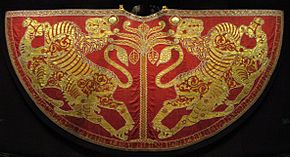
Back Kermes German Kirmeso Esperanto Grana (pigmento) Spanish שני (צבע) HE Grimiz Croatian Chermes Italian Coccum (tinctura) Latin Kermes (pewarna) Malay Kermes (kleurstof) Dutch Kırmız Turkish

Kermes is a red dye derived from the dried bodies of the females of a scale insect in the genus Kermes, primarily Kermes vermilio. The Kermes insects are native in the Mediterranean region and are parasites living on the sap of the host plant, the Kermes oak (Quercus coccifera) and the Palestine oak (Quercus calliprinos).[1]
These insects were used as a red dye since antiquity by the ancient Egyptians, Mesopotamians, Indians, Greeks, Romans, and Iranians. The dye also served a number of ritual and practical purposes in the Hebrew Bible.
The kermes dye is a rich red, a crimson. It has good colour fastness in silk and wool. It was much esteemed in the medieval era for dyeing silk and wool, particularly scarlet cloth. Following the Columbian exchange it was superseded by the similar, and more easily obtained, cochineal.